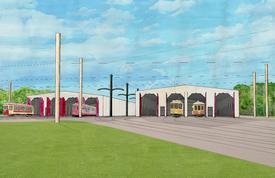|
|
Worst Flooding Ever, Museum Recovering
Hurricane Sandy brought the worst flooding ever to the museum, surpassing
the Irene storm of Aug 2011 by almost a foot. It could have been much, much
worse. The storm surge from this unusual hybrid system peaked at 9 feet,
comparable to what could be produced by a direct hit from a Category 3
hurricane. But the surge crested just a few hours before the time of
high tide. Had the storm come through 3 hours later, flooding would have
been equal to the 1938 hurricane (before the museum was established) and
would have caused unimaginable destruction to our collection.
14 cars came through the storm unscathed, and the museum resumed public
operations on Saturday, November 3 (Astronomy Night) and Sunday Nov 4
(Boy Scout Merit Badge). The Annual Meeting and Ground-Breaking ceremony
for Elevating the Collection has been re-scheduled for Saturday, Nov 17.
Yet despite this seemingly positive outcome, there is significant and
widespread damage to the rail car collection and shop facilities.
A number of cars flooded in Irene, and repaired in the last 14 months,
have been damaged again, and many other cars have received additional
flood damage. More significantly, the close brush with disaster should
remind all of us that Elevating the Collection is our most urgent priority.
Ironically, Hurricane Sandy struck the trolley museum just 5 days
before the scheduled ground-breaking for Elevating the Collection,
and just 14 months and one day after the museum was flooded by Hurricane
Irene. We know that you care about the museum and its collection. How
can you help break us out of this cycle of damage, repair and more damage?
The most important thing you can do right now is to support the
Elevating the Collection Bricks Drive which will help us reach
our fund-raising goal. Right now we are at 75% of the goal. Construction
of the buildings is imminent, and we need to raise the remaining 25% so
that we enter 2013 with the resources to complete the
entire project in this upcoming year and hopefully win the race against the
next devastating storm.
Please consider making a gift right now by going to our
online bricks
order page.
In the chapters below, we look at the preparation, aftermath and recovery
associated with Hurricane Sandy and the Trolley Museum.
Preparing for Hurricane Sandy
The Shore Line Trolley Museum was closed on Sunday, October 28
to prepare for the arrival of Hurricane Sandy. This caused
the cancellation of the final Pumpkin Patch day.
The museum received early warning from the Town of East Haven and
the State of CT on Wednesday. Preparations were made on Thursday
through Sunday. These included the following:
All tools and machinery in the shop were moved as high up as practical.
Critical maintenance equipment was placed by forklift onto a small
flatcar which was put on high trackage.
The forklift itself and other self-propelled maintenance
equipment was driven to higher ground.
All paper materials were removed from the Sprague Station basement
and brought into the main rooms.
Spare parts in the basement that would be most affected by flooding
were moved as high as possible.
The heating systems at Sprague Station and the Shop were partially
disassembled and critical components were stored up high.
At all signal locations along the line, low-lying components were unwired and removed to safe off-site storage.
Spare parts in the Substation were moved as high as possible.
Following the final car moves, the entire substation was de-energized.
Sandbags were placed around all of the basement and substation doors.
Cars were moved to higher tracks wherever possible. Only operational
cars were considered. There was neither time nor high track space to
protect those cars that had been previously flooded and not yet repaired.
The museum has very limited track space which is not low-lying. Based on
the flood forecasts, none of the yard and barn tracks were suitable, nor
was most of the main line. For the first time, we used the hilly tracks
in Riverside East and West curves. This carried a significant risk of
falling tree damage, and locations were carefully staked out to minimize
this risk, and to balance it against individual cars' abilities to withstand
a tree hit. Thus steel-roof subway cars could take spots in the curve in which
fragile wooden cars would not be safe.
The disposition of cars was as follows: 1349 with its motor truck at the
crest of the small hill leading to the Short Beach platform. Cars 1504 and
W-3 in Riverside East curve. Cars 5466, 3152, 1689, 6688 and 503 in Riverside
West curve. Cars 25, 850, 629 and a flatcar containing emergency generators
and other machinery in East Haven Curve. Cars 357, 1602 and 775 in front
of Sprague station. Cars 356 and Shunter on the pit with car 948 on the
pit lead just outside the door.
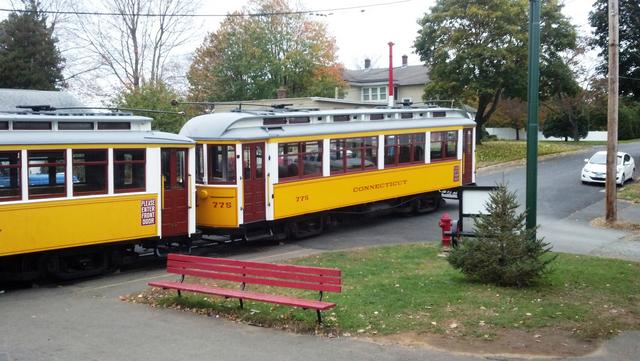 |
| This isn't a "photoshop" image. Car 775 has been deliberately run beyond the end of the rail to allow 3 cars to be stored in front of Sprague Station. R.Ryan |
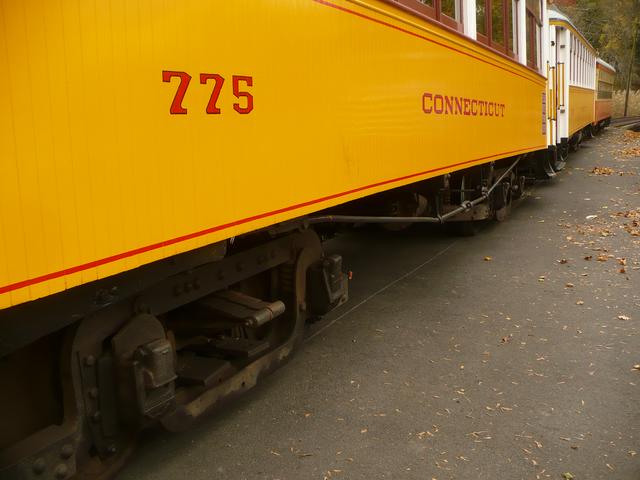 |
| One axle of 775 remains on the railhead while the others are in the asphalt. N.Nietering |
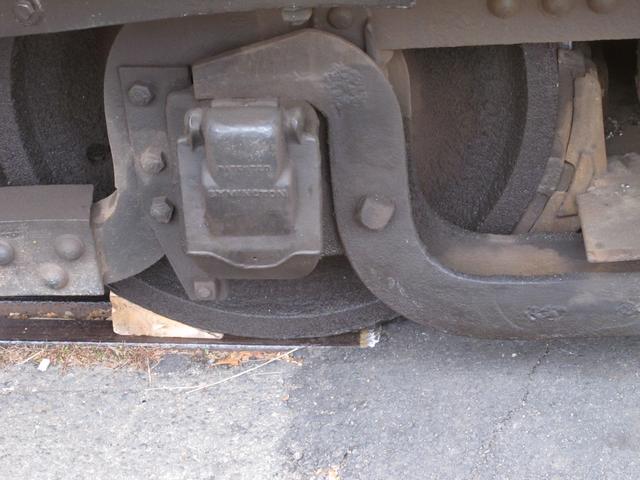 |
| Really, the car is still on the railhead. K. Rosen |
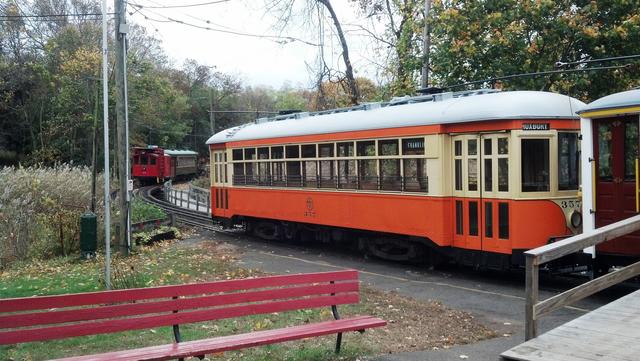 |
| Cars 357 and 1602 join 775 in the street. R.Ryan |
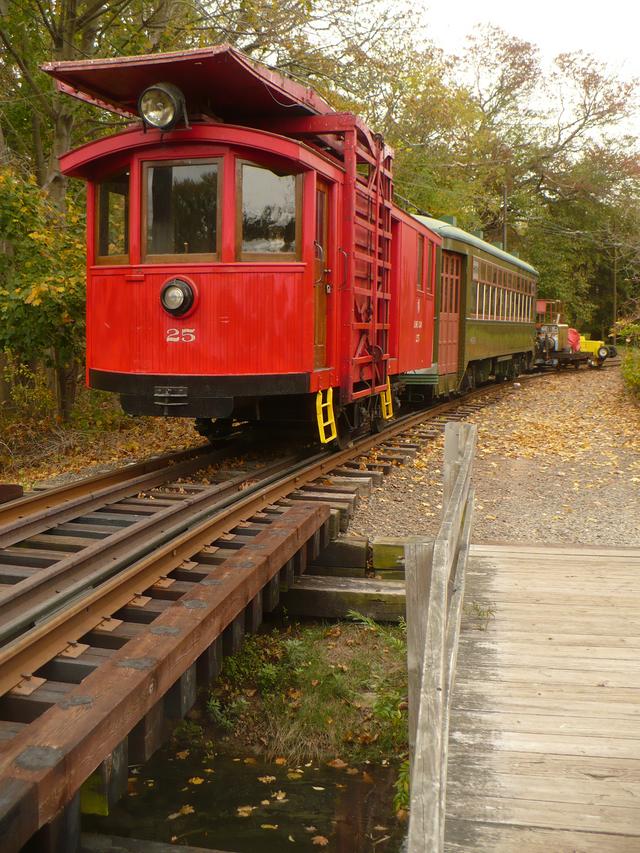 |
| Line car 25, New Orleans 850, and a flatcar with maintenance equipment are in East Haven curve. N.Nietering |
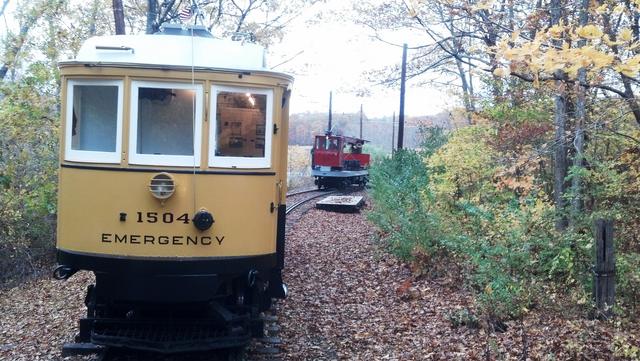 |
| Tool car 1504 is on the east side of the Quarry Trestle. Crane W-3 is pulling up to it. R.Ryan |
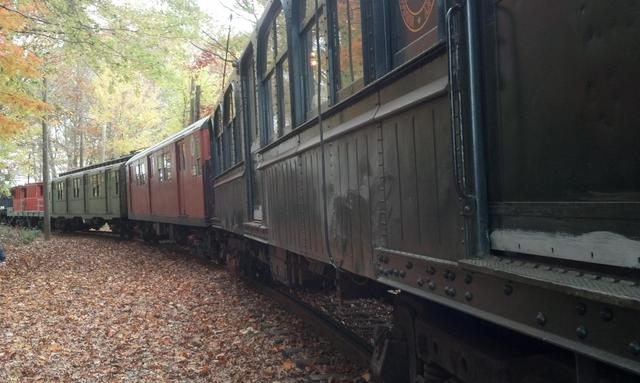 |
| Cars on the west side of the Quarry trestle are 5466, 3152, 1689, 6688 and 503. R.Ryan |
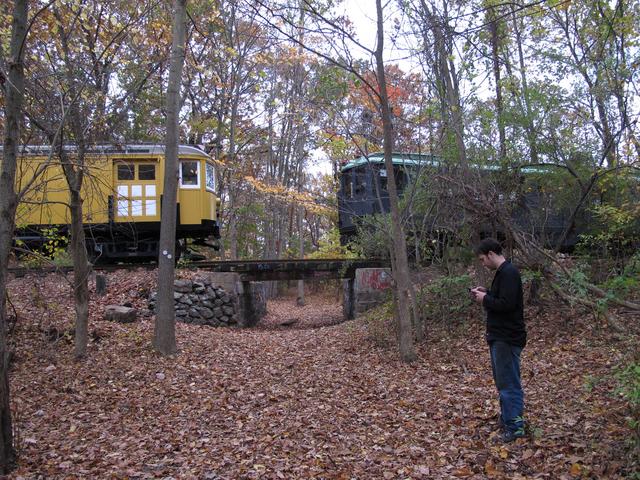 |
| Photographer Ken Rosen and Master Mechanic Dennis Pacelli are standing near the quarry looking railroad south towards the Quarry Trestle. |
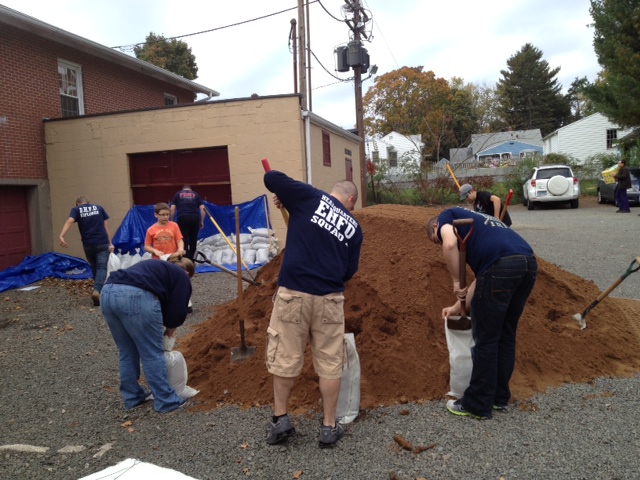 |
| East Haven volunteer firefighters filling up sandbags and applying them to the basement and substation doors. W. Sandford |
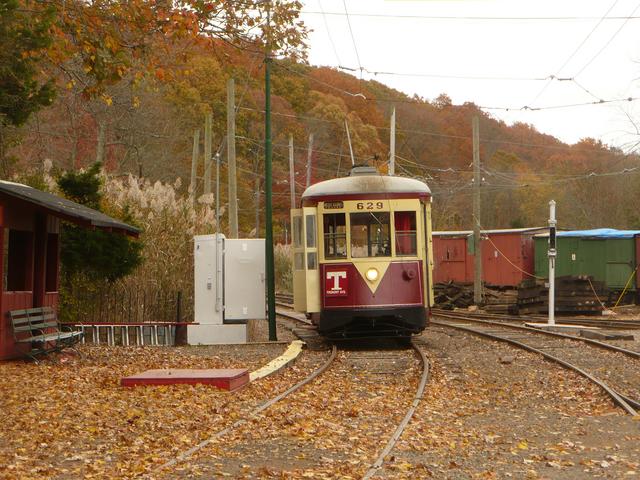 |
| 629 was used as the shuttle car during Sunday's car moves. Here it is picking up a load of signal relays. Shortly thereafter it was laid up in East Haven curve. N.Nietering |
During the Storm
During the storm, several members who live nearby and could safely drive to
the site came by to view the flooding. Unfortunately, in darkness and
driving rain, no photos came out. The storm surge peaked at 9 feet
around 9:30 PM, as the storm made landfall in New Jersey. As the storm
progressed inland, winds diminished and shifted in direction, allowing the
surge to reduce. But at the same time, the high tide at midnight was
coming in. The water crested at the museum around 10:30 PM, at an elevation
of 9.0' This is 10 inches higher than Irene, but 3 feet less than
the 1938 hurricane. Had that 9 foot storm surge come at or near midnight,
we would have seen a level of flooding that few people alive today remember.
The Morning After
Tuesday morning was cloudy, windy and showery. Several museum members
came to the site to begin the damage assessment process. The power was
out in most of East Haven and Branford. They did what they could with hand
tools to begin clearing debris and cleaning up.
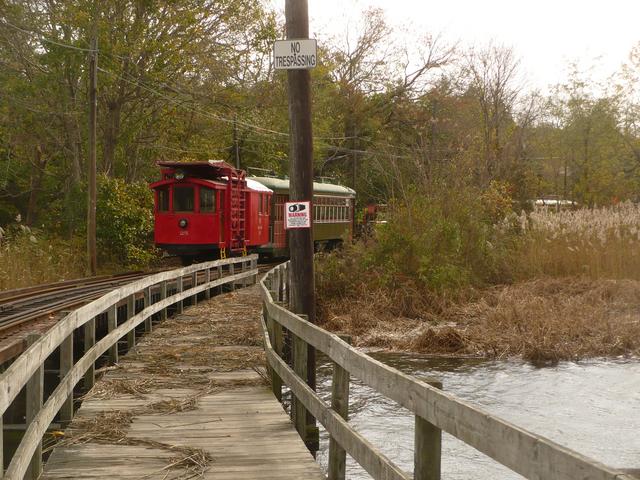 |
| Debris on the walkway shows that it was completely submerged. Cars were not stored on the trestle for safety reasons. The water reached about half-way up the ties but did not reach the rails on the trestle. N.Nietering |
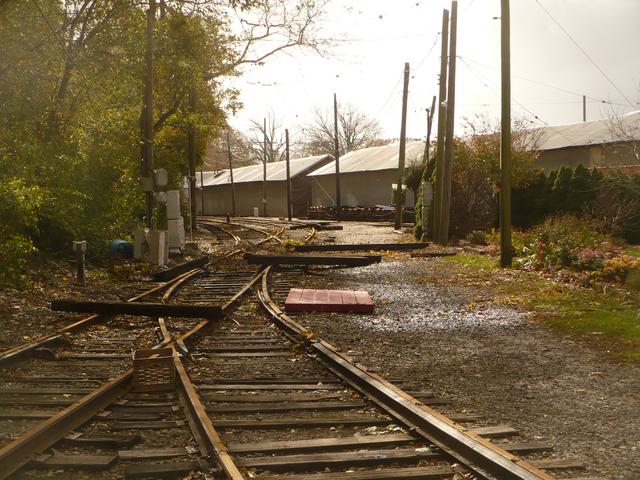 |
| The red loading platform has floated 400 feet from the outbound station stop. New and used ties, and marsh debris made the tracks impassable until cleared by hand. N.Nietering |
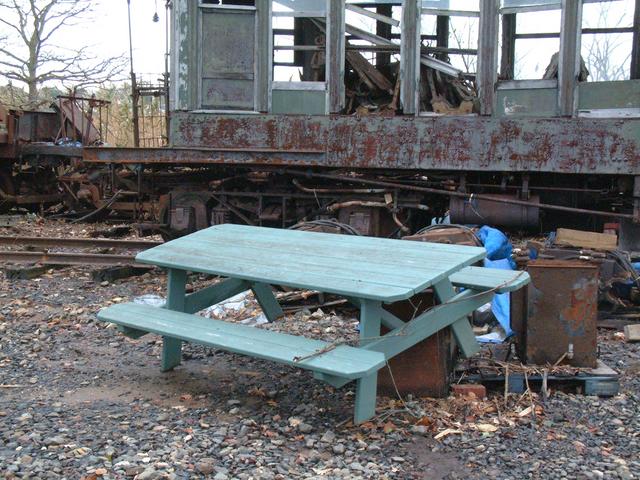 |
| This picnic table floated several hundred feet and came to rest on top of spare parts, which had been completely submerged. J.Hakner |
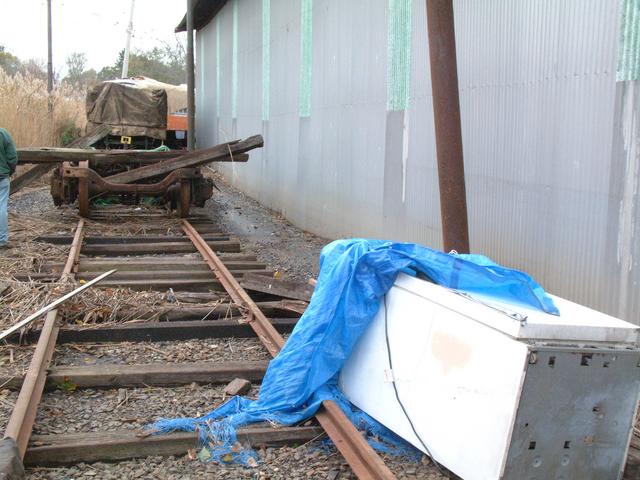 |
| Somehow a refrigerator wound up on the run-around track behind Barn 6. J.Hakner |
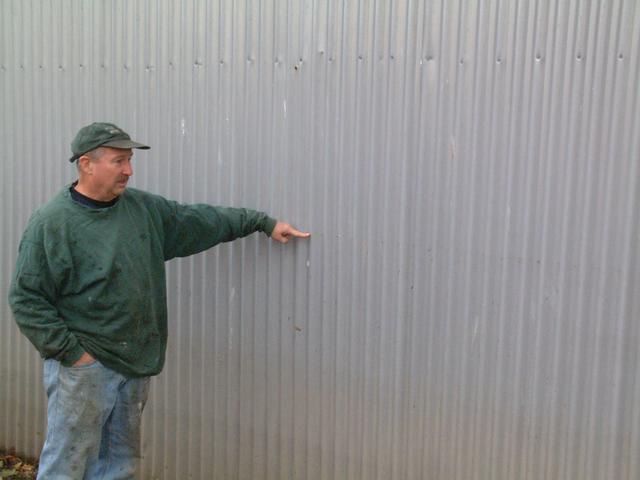 |
| General Manager Wayne Sandford shows the chest-high water line on the side of Barn 6. J.Hakner |
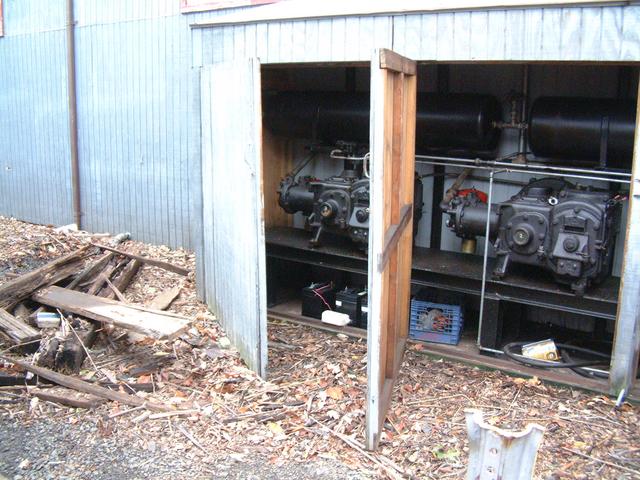 |
| Air compressors for the shop were flooded about half-way up, and now require rebuilding. J.Hakner |
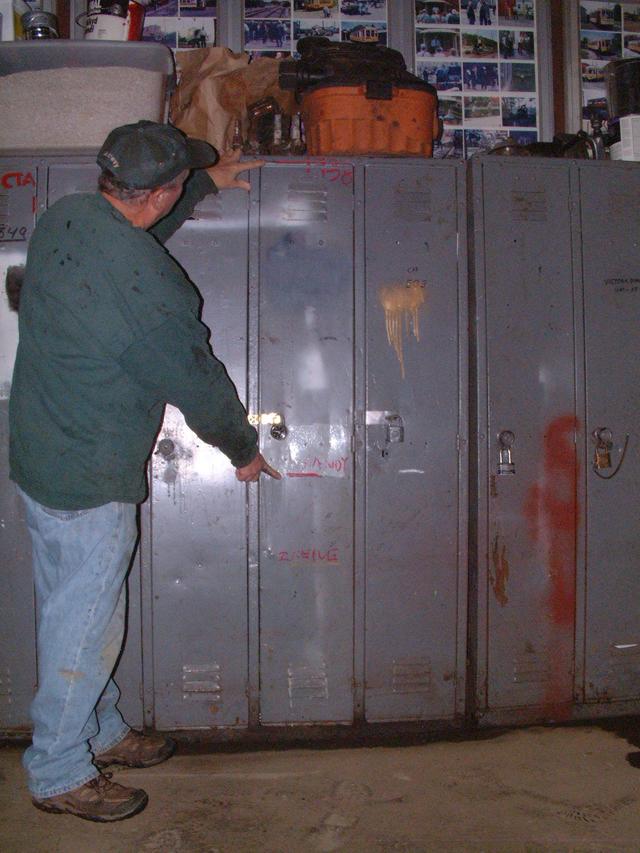 |
| Wayne shows the water level in the shop relative to the volunteers' lockers. IRENE at the bottom was 20 inches. SANDY was 30 inches above the floor, and Wayne's left hand points to what was narrowly avoided -- the 1938 flood level. J.Hakner |
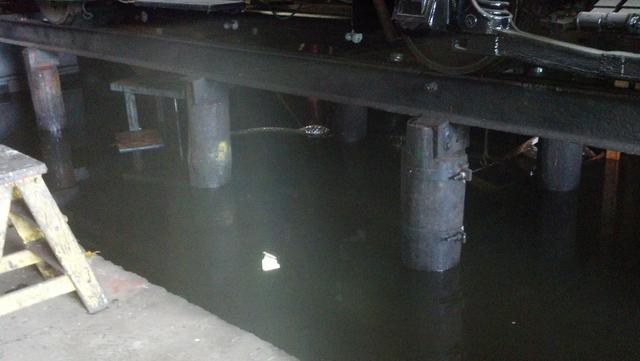 |
| The water level in the shop has receded, leaving the pit full of water that was pumped out right after this photo was taken. R.Ryan |
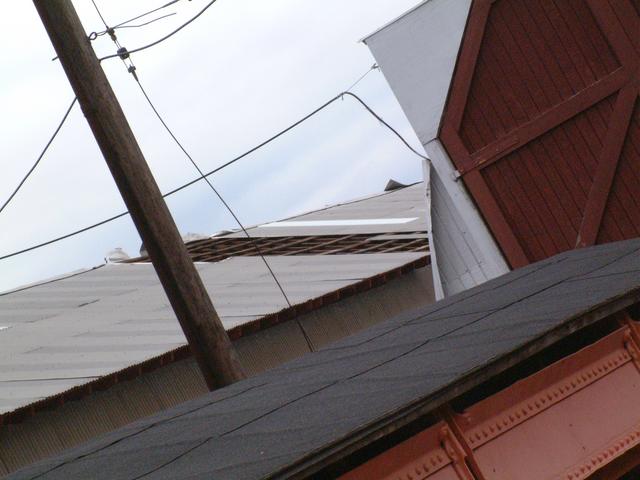 |
| There was significant roof damage to several of the barns. J.Hakner |
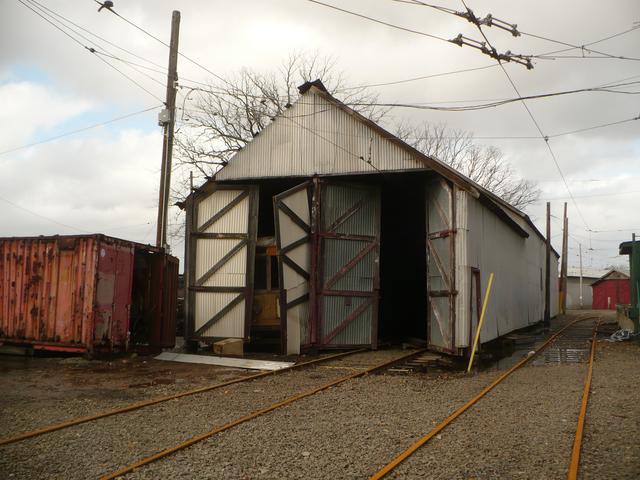 |
| The doors on one end of Barn 2 were damaged by the wind. N.Nietering |
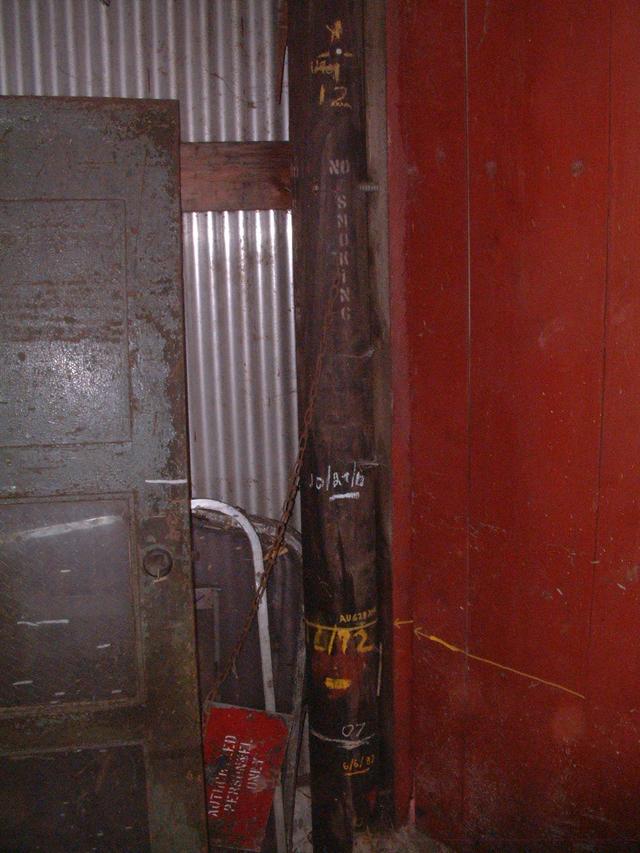 |
| The "pole of sorrow" in the corner of barn 6 shows various flood levels over the years: 1982, 1992, 2007, IRENE (2011) and SANDY (2012). At the top is a nail marking elevation 12.0, the 1938 flood level. J.Hakner |
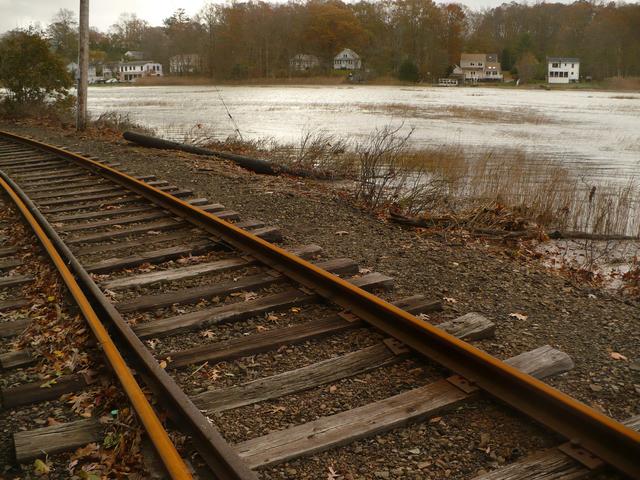 |
| In Riverside West curve, the bright orange stain on the rail head shows us that water covered this track. Note the unusually high tide which lingered for several tidal cycles. A few hundred feet down the track, as it ascends a steep grade, a number of cars escaped the flooding. N.Nietering |
Damage Assessment
A full damage report is still being prepared. At this time the following
preliminary damage assessment has been made:
- Railway
- Miraculously, not a single tree came down on the railway itself
and there was no damage to any of the cars stored outside, nor to the railway
track or overhead wire. This certainly
was unexpected considering the number of precariously overhanging trees.
The section of the line washed out during IRENE came through OK, thanks
to the hundreds of tons of stone ballast. Water entered several of the
signal cases, but because components had been removed ahead of time,
it is likely that signals will be reactivated this season.
- Buildings
- Barns 2, 4 and 6 had several large sections of roofing
blown off. Other barn buildings had scattered roof damage. The doors
on one end of Barn 2 were seriously damaged. There was only minor roof and
trim damage to Sprague Station. The sandbagging of the Sprague basement
and substation doors was partially successful. While water was as much
as three feet high against the exterior walls, there was only 6-8" of water
inside. The new Sprague furnace is apparently undamaged, and in the
substation, only a few parts and boxes on the floor were flooded.
- Shop
- With 30" of water across the main floor,
the machinery in the car restoration and repair shop sustained
serious damage, despite extraordinary measures taken in advance of the
storm. Both lathes, the surface grinder, boring mill, band saw, power
hacksaw and large drill press were all flooded. In some cases it is just
motor damage but in other cases water has gotten into the mechanisms.
The large oven used to dry out motor windings was also flooded and will
required repair before it can be used again. The shop compressed air
system was flooded and thus there is no compressed air. A portable
compressor will have to be brought in. The motor used to derive
the 3-phase power has been flooded, although this is somewhat of a moot
point since all of our 3-phase machines have also been flooded. However,
the heavy-duty 3-phase motor-alternator converter escaped flooding.
The electric car jacks received slight flooding in the control boxes.
Many tools, parts, fittings and supplies were flooded.
- Spare Parts
- For the first time, flood waters were high enough to
enter most of the spare parts storage containers. Many spare motors
and compressors stored within received at least some flooding. Other spare
parts stored outside have been completely immersed.
- Vehicle Collection
- Considering first the cars that had been
operational as SANDY approached, 14 cars (775, 1602, 357, 25, 850, 356, Shunter,
503, 6688, 3152, 1689, 5466, W-3, 1504 and 1349) were above the flood.
Car 629 received a few inches of flooding to the motors, while 948,
on the pit lead, was above the flood on one end, and about 12" deep on
the other. Cars 1911 and 2001 were flooded 17-18" deep. In the case of
2001, water entered the compressor and line switch. Car 1001 was also
flooded 17-18", meaning water has now possibly entered the motor-generator
and control group. All of the other cars, including those that had
been operational before IRENE but had not yet been repaired, have now
been flooded even more. 10 inches may not seem like much of a difference
when a typical car is 10-12 feet high, but water has now entered areas of
these cars such as compressors, control groups, and air valves, which
may lead to serious and costly damage, in addition to traction motors,
gear cases and bearings, which have been completely submerged.
Several members have been assigned a dozen cars each to inspect. A full
report will be compiled in the coming weeks and shared with the membership.
Cleanup and Recovery
By Wednesday, Oct 31, enough debris had been cleared from the tracks to
begin moving cars. With no external power, a gasoline welder/generator
was used to energize the trolley wire with low voltage, high-current DC,
and cars 629, 850, 25, 357, 1602 and 775 were moved back to the barns
in this manner, with some help from the TrackMobile car mover, and the
Diamond-T wrecker truck. Although 775 had run itself 3 axles beyond the
rail head, on this reduced power it could not pull back on, and the wrecker's
winch was used to give it a start.
Meanwhile, the substation was inspected and found to be undamaged.
Preparations were made for re-energizing. Power was restored overnight,
and on Thursday the trolley wire was again energized with 600 volts.
The remaining cars down the line were brought back in under their own power
and cleanup continued through the weekend. We were able to operate our
scheduled special events on Saturday night (Astronomy Night) and Sunday (Boy
Scout Merit Badge) using the 4 revenue trolleys available.
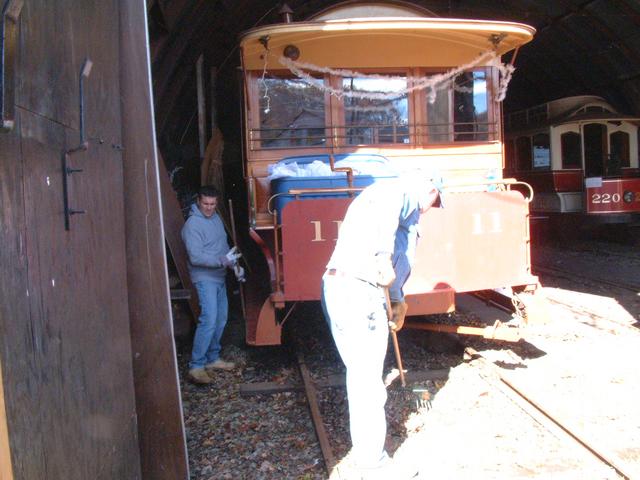 |
| Museum volunteers clean up debris and ready Barn 1 for our Holiday Season displays. J.Hakner |
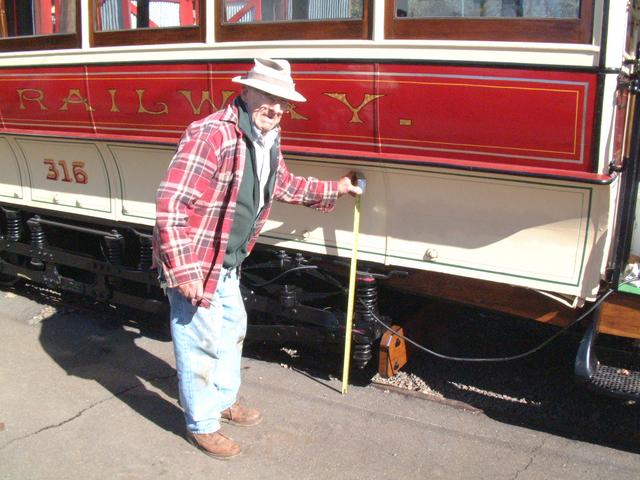 |
| Ron has been a member of the museum since 1947 and restored car 316. It was flooded in IRENE and subsequently repaired. He takes a measurement of flood levels from IRENE vs SANDY. J.Hakner |
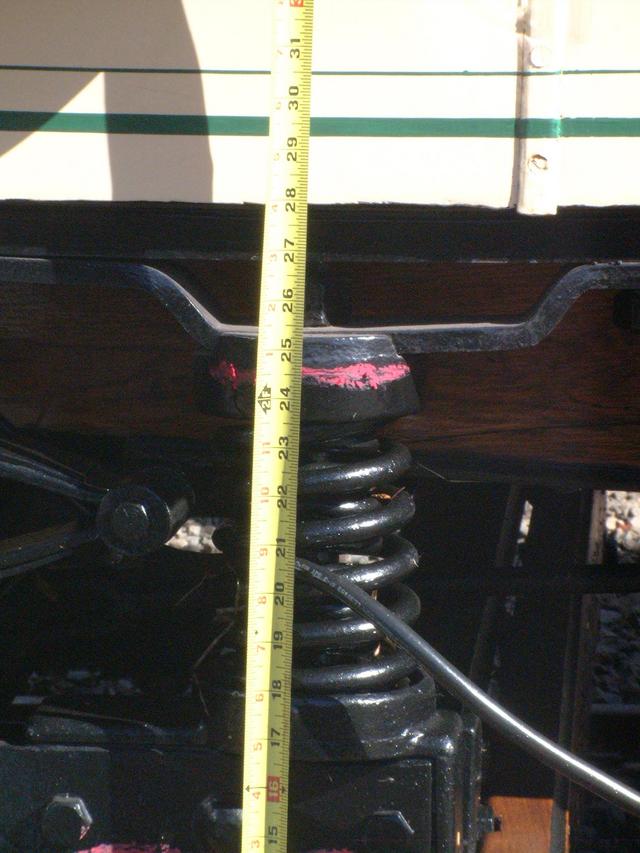 |
| SANDY at 24.5 inches above the rail, and IRENE at the bottom of the photo at 14.5 inches |
Shop and barn cleanup was
difficult because of the lack of power (these buildings are in the town
of Branford, and are fed from a different electrical service). On Saturday,
car 316 was towed out of Barn 1 and cleanup began. Water was drained from
the motors and bearings, and the salt water residue was flushed out with
fresh water. By Sunday night, barn and shop power had been restored.
Where do we go from here?
Our time is limited with cold weather approaching. A certain amount
of "triage" is necessary to remove water from cars where freezing this
winter would result in serious damage, and to flush the salt to avoid
heavy corrosion. At the same time preparations for the start of
construction for Elevating the Collection must be completed, and of course
we must operate our regularly scheduled Santa/Winter Season program, which
brings in a lot of visitors for the museum.
Hanging over our heads is the potential for yet another serious storm and
flood. While it could happen at any time, the most dangerous months
are late summer through the fall, when hurricanes are most active in
the Atlantic. The museum has been given two reprieves, in a manner of
speaking. Both IRENE and SANDY nearly caused catastrophic flooding damage.
We are grateful to have received merely major, widespread damage. It is
not at all certain that the museum, in its given state, would be able
to survive a flood such as that of 1938.
With 75% of our $2 million goal for Elevating the Collection already raised,
including a grant from the State of CT,
the buildings will rise above the flood plain in 2013. Had these buildings
and tracks been in place, all of the cars flooded during IRENE and
SANDY would have been completely safe. Let's complete
this fund-raising campaign now, in 2012, so that building construction can
be followed immediately by tracks and wires. Let's win the race against
the next storm.
Please visit ElevatingtheCollection.ORG and consider making, or increasing, your gift to the campaign.
Buy a brick, or several bricks, right now, and have your support of
the museum memorialized in perpetuity. Together we can make this happen!
|


























